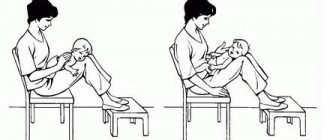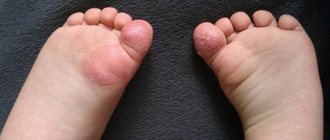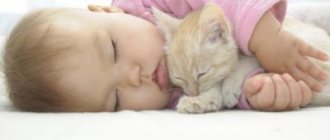To make an appointment with a doctor
Calling a pediatrician to your home
Our doctors
Our prices
January 30, 2021
Author of the article: Uzuev Magomed Isaevich
Member of the Association of Ophthalmologists and Strabismologists, ophthalmic surgeon. Practicing pediatric eye surgeon
Experience: 8 years
+ Make an appointment
What to do if your child’s eyes start to water a lot? How dangerous can this be? Is it worth paying attention to this or is this a temporary phenomenon that will go away on its own? The answer is clear: parents need to pay attention to this and find out the cause of lacrimation. Often, lacrimation from one eye in a child is a sign of the development of an infectious disease, a cold, or a manifestation of an allergic reaction. Moreover, such a manifestation may be a consequence of injury, and it is important to prevent vision deterioration. But in order to take effective measures to eliminate the problem, you must absolutely know the cause. Therefore, in most cases it is necessary to contact a specialist, and sometimes more than one.
Causes of lacrimation in children
Experts identify several main causes of watery eyes in a child. At the same time, the symptoms and nature of the course in them differ significantly. Therefore, we propose to consider each group of reasons in detail.
Conjunctivitis is a fairly common infectious disease that often occurs in children. Inflammation develops as a result of infection entering the body. And it can get there in various ways, even with a speck of dust brought into the eye. The inflammatory process is accompanied by profuse lacrimation and redness of the white of the eye. Also, accompanying symptoms for various types of conjunctivitis may be swelling and swelling of the eyelids, and unpleasant painful sensations. As with any other problem, it is better to start treatment as early as possible, then it will be the most effective and least lengthy.
Main types of conjunctivitis:
- adenoviral – accompanies various viral diseases (for example, ARVI, influenza, etc.). As a result, the child experiences severe irritation of the cornea, lacrimation and redness of the whites;
- bacterial – caused by the penetration of bacteria into the eye. The risk of infection is present when debris accidentally gets into the eye or when rubbing the eyes with contaminated hands. As a result of the introduction of pathogenic microorganisms, an inflammatory process begins, which is accompanied by profuse lacrimation and painful sensations; in advanced cases, copious discharge of pus is possible;
- allergic – caused by contact with a corresponding allergen irritant. Symptoms appear immediately after contact and are usually pronounced.
Barley. It looks like a compaction localized on the eyelid. The seal tends to quickly increase in size. At the same time, an inflammatory process occurs inside the seal and a barley sac is formed, in which pus accumulates. As the stye sac grows, the discomfort it creates for the eye also increases. Irritation is accompanied by strong release of tear fluid. The cause of stye may be the child's hypothermia or debris and dust getting into the eye.
Dacryocystitis of the newborn. It can be diagnosed in a baby in the first weeks of life. The fact is that immediately after birth, the nasolacrimal canal, through which the tear fluid actually passes, may not yet be open, that is, congenital obstruction is present. As a result, the baby's tear fluid is removed from the eyes, and it looks like excessive lacrimation. The canal will gradually open, and with its opening, the tearing from the child’s eyes will stop.
Entry of a foreign body. It's no secret that the eye is a very vulnerable organ. The entry of foreign objects into it is of a shock nature and can injure the squirrel. Even if the blow was not strong, it causes a defensive reaction - copious release of tear fluid. It actively moistens the injured area and thus helps remove the foreign body from the eye.
Exposure to a computer or other modern gadgets. Prolonged use of computer equipment and smartphones without rest for the eyes leads to drying out of the cornea, as the number of blinks decreases. Due to drying out, the cornea becomes irritated, which causes active lacrimation in children. And this once again demonstrates that the use of computer technology by children and adults must be correct.
Reasons why the little eye cries
There are many reasons why only 1 organ of vision may become watery:
- Penetration of a pathogenic microorganism. It could be a bacterium, a virus, a parasite, or a fungus. They can penetrate from the outside, under the influence of negative environmental factors, during interaction with an infected person. Also, the lesion may be in a neighboring organ. For example, a child may have sinusitis or a systemic viral disease that migrates first to one organ of vision, then to another.
- Allergy. It can appear seasonally during flowering plants. It could be ambrosia, poplar fluff. Allergic reactions also occur to household factors, for example, household products, animal hair, house dust.
- Colds. One of the symptoms of colds is increased tearing. This condition can be observed only in one organ of vision. If there is no treatment, the damage may gradually spread to the second eye.
- Pathology of tear fluid secretion (dacryocystitis). For example, if the channel for the secretion of tears is blocked, when exposed to negative environmental factors or the child cries, fluid will be released only on one organ of vision. The cause may also be inflammation of the lacrimal sac or gland. Then increased functionality is formed in this area, tear fluid is constantly released unnecessarily.
- Disease of the ENT organs. Increased secretion of tear fluid occurs with sinusitis (inflammation of the sinuses) or otitis (inflammation of the hearing organ). Moreover, the secretion of tears occurs from the side on which the inflamed organ is affected. That is, if there is inflammation of the auditory tube on the right, the right eye will water.
- Penetration of a foreign body. This could be a minor speck or large foreign objects, such as glass. In some cases, only lacrimation is formed, in others the mucous membrane and stratum corneum of the eye will be damaged. The condition is also accompanied by additional symptoms in the form of severe redness and inflammation.
For each cause of increased tear production in only one eye, there is a specific treatment strategy. Therefore, the doctor must use diagnostic tests to identify the root cause, only then begin therapy.
Diagnosis of lacrimation in children
Since the causes of lacrimation in children vary significantly, accurate diagnosis is very important. It is necessary for choosing a treatment method.
Let us outline the main diagnostic methods that parents can perform to decide which doctor to see.
- A visual examination of your child's eyes to determine if watery eyes are caused by injury or contamination. In case of injury, assistance from an ophthalmologist and traumatologist may be required.
- Measuring body temperature and examining the throat for redness. Fever and the presence of redness are signs of ARVI or influenza. In this case, consultation with a therapist is necessary.
- The formation of pus and severe redness of the eyelids may indicate a viral eye infection. In this case, you need to contact an ophthalmologist.
If parents find it difficult to determine the cause of lacrimation, a visit to a therapist is recommended, who will refer them to a specialist.
Main types and causes of discharge
Depending on the provoking factor, discharge from the eyes of a child may vary:
- clear discharge often appears when something gets into the eyes or during an allergic reaction. Allergens can be either external (pollen, household dust, etc.) or internal, food;
- copious yellowish discharge with a viscous consistency, which promotes sticking of the eyelids, most often indicates conjunctivitis or other infectious inflammatory processes that easily develop if basic hygiene is not observed. Such discharge is most abundant in the morning immediately after waking up, since the affected glands produce it most actively during sleep;
- With blepharitis, a child may experience thick yellow-green discharge, which contributes to the formation of scales and crusts on the eyelids. This inflammatory disease is contagious; you can catch it either in kindergarten or school, or on the street;
- mucopurulent discharge appearing from the lacrimal openings, accompanied by redness and soreness of the eyelids, indicate dacryocystitis - obstruction of the lacrimal canal. Sometimes this disease is congenital, but more often stagnation of fluid in the lacrimal canal occurs due to infection by pathogenic microorganisms.
Discharge from the eyes requires the supervision of a doctor who can conduct a detailed examination of the child and prescribe appropriate treatment. You must understand that most infectious and inflammatory diseases of the organs of vision can lead to extremely undesirable consequences, and therefore you should not try to treat the child yourself with the help of folk remedies and medications.
When to see a doctor
Seeing a doctor for watery eyes in children is not mandatory in all cases. If the reason is a long stay at the computer, then a break from this type of activity will solve the problem. The eyes will stop straining, normal hydration of the cornea will be present and lacrimation will stop.
Things are different when the causes of lacrimation are different and certain symptoms are present.
- The child has watery eyes and a severe runny nose - these symptoms are characteristic of both allergic reactions and cold viral diseases. It is noteworthy that reddening of the proteins is also characteristic in both cases. Allergic reactions are characterized by pronounced swelling and swelling of not only the eyelids, but also the bridge of the nose. But this cannot be a decisive factor for parents to independently determine the cause of lacrimation in a child. Therefore, you will need to contact a specialist. If the child has not previously had allergic reactions, then there is a high probability of an infectious disease. But a specialist will be able to accurately diagnose the cause using additional research methods.
- The child's eyes are watery and there is an elevated body temperature - this combination of symptoms often indicates a viral infection (acute respiratory infection, sore throat, flu, etc.). At elevated temperatures, redness of the whites is always observed, the eyes become irritated, and lacrimation increases. This is a normal protective reaction during infectious diseases.
So, we conclude that if lacrimation is combined with other symptoms, you need to consult an appropriate doctor. Watery eyes, runny nose and fever may require the help of a pediatrician, as these are symptoms of viral colds. If lacrimation and runny nose are allergic in nature, consultation with a pediatric allergist is required. If watery eyes are combined with swelling and the appearance of pus, you should contact a pediatric ophthalmologist to prevent the spread of infection in the eye.
Prevention
To prevent the primary or repeated secretion of tears from only one eye, the following rules should be followed:
- periodically perform a massage for the lacrimal canal, it is recommended to do it daily if the child has difficulty releasing tears;
- preventive examination by a pediatrician, ophthalmologist, otolaryngologist;
- timely treatment of systemic diseases;
- maintaining eye hygiene procedures to prevent the spread of viruses and infections;
- absence of visiting public places during an epidemic of viruses or infections;
- the use of physiotherapy if prescribed by a doctor.
The discharge of tear fluid from one eye in a child may mean a temporary phenomenon or an intense pathological process. To avoid complications, it is recommended to consult a doctor in a timely manner and carry out all necessary manipulations. With timely treatment, the risk of chronic ophthalmological diseases is significantly reduced.
Treatment
The choice of treatment method directly depends on the identified cause. For each case - be it an infectious disease, an allergic reaction or a cold, there is a different treatment protocol.
The specialist also takes into account the individual characteristics of the child, the presence of concomitant or chronic diseases, and the general condition of the patient. In case of simple exposure to dust and debris, simply washing the eyes with a decoction of chamomile or sage may be sufficient to relieve irritation.
For a cold that is accompanied by conjunctivitis and lacrimation, the emphasis is on treating the cold itself and treating the eyes to relieve irritation and symptoms. Treatment of infectious diseases may require the use of antibacterial drugs.
If the problem is of an allergic nature, first of all it is necessary to eliminate contact with the allergen, and in the future try to exclude the possibility of such contacts.
Main reasons
There are many reasons that lead to watery eyes in children.
The most common ones are:
- Congenital abnormalities of the lacrimal glands or ducts.
The channels can be lengthened, shortened, or have an unnatural shape. If the pathology is congenital, then its first manifestations (watery eyes) begin in the first 1-2 years of the child. The irregular shape of the lacrimal canal makes it vulnerable to various infections, so these children easily develop inflammation. - If the baby has watering in only one eye, the problem may be a violation of the outflow of fluid , which is caused by the entry of a foreign body, for example, dust or an eyelash. This happens at any age, but is most often observed at 3-4 years old, when the baby is already actively playing, including on the street.
- Benign or malignant tumors can occur at any age.
They lead to tearing on one side. The tumor gradually increases in size, squeezing the surrounding tissues, the baby may feel pain and pressure. Malignant tumors are especially dangerous - basal cell carcinoma and squamous cell carcinoma. They develop rapidly, easily grow into neighboring tissues and organs, and one of the characteristic signs is bleeding. - Mechanical injuries.
They may be accompanied by hematomas (bruises) under the eyes, damage to blood vessels, as a result of which the white of the eye becomes filled with blood and becomes red. Tearing may continue for several days after the injury, accompanied by bleeding, and even longer if an infection gets into the eye. The likelihood of such injuries increases with age, mobility, and independence. - Infectious diseases.
The most common of these is conjunctivitis, which occurs as an independent disease or as a complication after the flu. Conjunctivitis occurs at any age and usually affects both eyes. Characteristic symptoms are “sticking” of the eye in the morning and suppuration. The eyes water constantly until the baby recovers completely. - With allergies, both eyes water. This is accompanied by sneezing, runny nose, and skin rashes.
- The most harmless reason is temperature changes. At any age, your eyes water if you leave a warm room into cold air.
- Malignant tumors of the pituitary gland and pathologies of the nervous system lead to lacrimation. The release of tears sometimes occurs without a clear pattern or apparent reason.
Prevention of lacrimation in children
Experts recommend the following as preventive measures.
- Regular walks in the fresh air. Staying in the fresh air helps saturate the eyes with oxygen, which in turn strengthens it and promotes the proper development of this organ.
- Taking special vitamin complexes aimed at improving vision. Proper nutrition is also an important point - the diet should include the nutrients necessary for the eyes.
- Gymnastics for the eyes is recommended. It should be performed daily. A set of special exercises helps strengthen the eye muscles, relieve tension and ultimately maintain healthy vision.
- Children should adhere to a routine of working with the computer and other types of gadgets. Every hour you should take breaks of 10-15 minutes.









